How To Save Transparent Background In Paint Tool Sai
For many artists, it's likely that yous'll want to save transparent drawings at some point, for their uses in layouts and graphics and otherwise. And given that Photoshop every bit an expensive investment and Paint Tool SAI (which tends to lack transparency in various versions) is and then pop, it tin can be difficult to know how precisely to achieve this. This is where I'll endeavor to help!
Checking if your Paint Tool SAI secretly has transparency
SAI tin be a bit difficult to figure out when it comes to this, but some versions practice indeed have transparency support. Here'south how to practise it when you practise have one of those versions:
For SAI 1
![[Pictured: SAI 1's layers, with the background layer selected and hidden.]](https://noseclub.bluwiikoon.art/img/tr-1.png)
First of all, make sure whatever background layers you have are hidden. SAI 1 won't prove you any checkerboxes in the background for transparency, merely you lot tin can bank check if your drawing is see-through by filling a layer underneath with black (and and so hiding it again, of form).
![[Pictured: A cute, see-through Nosepass with a black backgroud.]](https://noseclub.bluwiikoon.art/img/tr-2.png)
You can run into the black groundwork on this Nosepass, so it's good to go. Brand certain y'all hide that blackness layer again!
From hither, click on File, become to Export as, select .png, and blazon in whatever filename you'd similar.
![[Pictured: The File, Export and .png shown as stated above.]](https://noseclub.bluwiikoon.art/img/tr-3.png)
If your SAI supports transparency, the beneath dialog box should popular up after y'all save it.
![[Pictured: A dialog box for PNG Save Options, showing 24bpp RGB and 32bpp ARGB options.]](https://noseclub.bluwiikoon.art/img/tr-4.png)
You want to select 32bpp ARGB (Each pixel have Opacity) for a transparent image. With any luck, it'll work perfectly!
For SAI 2
Paint Tool SAI 2 makes transparency a bit easier to run across. Similarly to above, hide any background layers, and so click on Canvas, hover over Background, and select Transparent (Bright checker).
![[Pictured: The Canvas, Background and Transparent options as detailed above.]](https://noseclub.bluwiikoon.art/img/tr-5.png)
If your cartoon is transparent, it should evidence immediately with some gray checkerboxes. For a very high res picture, you may have to zoom in to see them, though!
![[Pictured: Nosepass with grey checkerboxes in the background.]](https://noseclub.bluwiikoon.art/img/tr-6.png)
And again, consign it and relieve information technology. SAI 2 should handle any transparency automatically, as long as y'all save your file as .png. This is very important, so please make sure information technology's .png.
![[Pictured: Fully transparent Nosepass!]](https://noseclub.bluwiikoon.art/img/tr-7.png)
Congratulate yourself on your luck, your version of SAI supports transparency!
When your version of SAI cannot make things transparent
It's unfortunate, simply with so many versions floating around some of them simply can't practise it. Here is how you tin piece of work around that.
Step One: Ensuring your drawing is appropriate for transparency
Since well-nigh art programs start you lot with a white background, including SAI, a lot of people don't feel the need to fill in white colouring (such every bit eyes) or make clean upwards any light pixels that may leak from the linework. By creating a temporary groundwork layer underneath everything that's filled with black, yous tin ready upwardly these instances and ensure they expect good on every background.
![[Pictured: Identical Wooper drawings on a white and black background.]](https://noseclub.bluwiikoon.art/img/woop-1.png)
As you can run across above, in that location's no pixelly edges or leaky colouring on the Wooper with a nighttime groundwork, and its eye whites have been filled in. Otherwise, the Wooper would have black eyes and look a little spooky!
Stride Two: Preserving your layers in a cross-compatible format
![[Pictured: Wooper shown with the layers used to make its image.]](https://noseclub.bluwiikoon.art/img/woop-2.png)
For the sake of ease it's vital that you have an file with layers rather than a flat image. It is still possible to cutting out a drawing that's been flattened onto an opaque groundwork, simply we'll get into that a fleck later.

You lot will ideally want to consign your art as a .PSD, as seen in a higher place. While it may technically be a Photoshop file, certain gratuitous image programs are compatible with .PSD files and can be used to open up and edit them.
Step Three: Alas, you must download 1 of them
With Photoshop presumably unavailable to y'all, you'll accept to download a specific image-editing software to add transparency. The best selection for this is GIMP, as it'due south completely costless of accuse to utilise and uniform with both Windows and Mac. It may seem complicated at first, but don't worry!
Stride Iv: Opening files is a struggle
In one case y'all've downloaded GIMP and installed information technology (presumably with custom settings!), the very side by side step is opening it up and and so opening your .PSD file in information technology. Be patient, as GIMP tin take a while to start. It can also exist a bit jarring, since by default information technology opens several small windows rather than one big window. But as usual, clicking on File so Open up will go y'all to the file selection prompt. However, I will recommend putting things you lot want to edit in a small-scale and hands-accessible binder, since GIMP's file viewer has its own interface and lists everything by filename.
![[Pictured: GIMP's overwhelming file viewer, with a list of non-specific Nosepass filenames.]](https://noseclub.bluwiikoon.art/img/woop-4.png)
How could this happen to me...
Once you detect your image, it should exist smoothen sailing!
![[Pictured: Wooper's layers didn't work as plan, and it looks a little spooky.]](https://noseclub.bluwiikoon.art/img/woop-5.png)
...However, if you use clipping grouping layers as much every bit I practise in SAI1, you may desire to merge those specific ones with the layer underneath when you're prepping the file. Whoops! As of at present, I don't know how to set up this in GIMP itself, merely doing the needed edits to the .PSD in SAI is like shooting fish in a barrel enough.
![[Pictured: Showing a layer with the Clipping Group option selected in SAI, and the layer underneath.]](https://noseclub.bluwiikoon.art/img/woop-6.png)
Then to reiterate, merge Clipping Group layers (identifiable by the box being ticked and the pinkish line on the side every bit seen above) with the layer they're fastened to. If yous practice it correctly, your epitome will expect exactly the aforementioned, except not broken when yous open them in GIMP. Simple!
Stride Five: It's finally time
Upon opening the fixed file in GIMP, the next step is refreshingly unproblematic: You find the background layer on your film (whether it'southward a white groundwork or a temporarily coloured ane) and delete it.
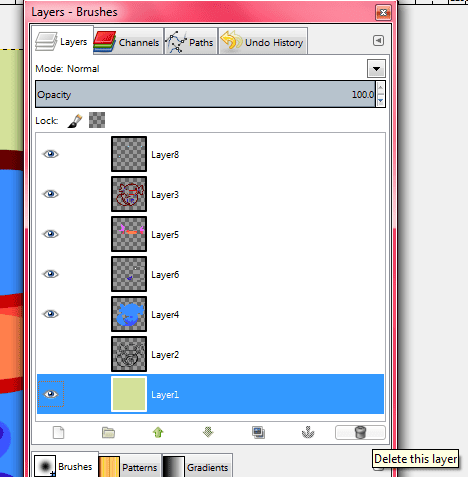
The background of your picture should alter to grey checkerboxes, as yous can see below. This ways it worked!
![[Pictured: Wooper with a grey checkerboard pattern background, showing that it's transparent.]](https://noseclub.bluwiikoon.art/img/woop-8.png)
Footstep Vi: Saving your picture
GIMP naturally has an unintuitive way of saving images, too. Here's what you'll want to do:
With that, your picture should be transparent! Yous can tell when you click on it in your folders, and the blue selection color shows through!

From here, information technology's downwardly to you what you'll employ your transparent pictures for. Enjoy your newfound power, and have fun!

"Just what if my image is flat?"
Non every paradigm is blest with layers, and then for those cases y'all'll have to practice things the hard way. Depending on the style, you can either zoom in really close with an eraser and delete the backgrounds past hand, or a simple selection trick will piece of work.
Step Ane: Selecting and removing the unwanted space
First of all, delight make sure you're editing either your own art or art that is actually official, fifty-fifty if yous have to triple-check to be certain. Editing other artists' piece of work isn't cool, whereas official renders and official Pokémon images are bachelor for everyone to use in articles and publications (and by extension, graphics).
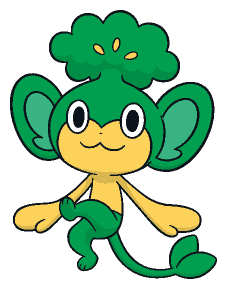
And so, what tin we do nigh this Pansage's official art? The lines are a solid nighttime colour so it's adequately safety to employ a choice tool. For a program like SAI, it's best to make a night layer underneath (even if it isn't visible at first) and edit your option settings until you have most of the unwanted colour selected. Anti-aliasing is what you'll need for a smooth edge, but if yous're editing pixel art it'll have to be unticked for a pixelly edge.
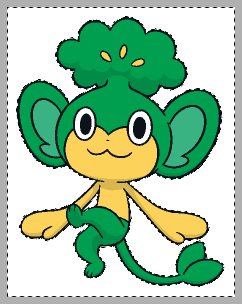
At this point a good trick is clicking on Selection and Increment, and so using Cutting to remove the white space. Simply for a minor prototype like this Pansage, it will more than than probable take abroad a portion of the linework.
Step 2: Quickly fixing the linework
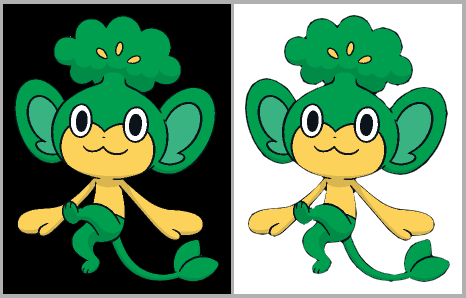
Information technology won't e'er be a perfect solution, but for a film similar this you can select the outside of the prototype over again, Capsize the selection, Increment information technology (or Dilate Option 1px in SAI2), and fill it with the outline color on a layer underneath. You lot may also have to increment it multiple times until it looks juuuust right. It's not platonic, and for many cases you might want to zoom in and practice some editing to get information technology looking just right. At the very to the lowest degree, it'southward a quick method with quick results.
Step Three: In-depth editing
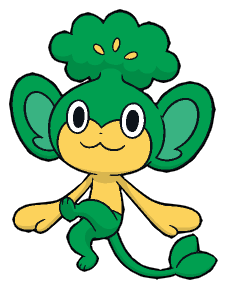
Y'all may not be fully satisfied with how it looks at this point - this Pansage has some jagged edges along its lines and looks a bit messy. If you lot are willing to go the actress step, you tin can zoom in and employ a 1px anti-aliased brush and 1px eraser to ready the edges until it looks right to you lot. If it'south your own art you're editing, it'due south fully down to your discretion.

Since this Pansage is Global Link art, I merely felt comfortable editing simply the edges. It does await a lot better at present, though, and information technology's fully transparent! Merely imagine all the absurd graphics I could make with such a practiced, transparent friend.
Above all else, stay adamant. You can make all the transparent pictures if you endeavor!
Page concluding updated on 14th November 2017 at 00:47 GMT.
How To Save Transparent Background In Paint Tool Sai,
Source: https://noseclub.bluwiikoon.art/transparency.shtml
Posted by: wilsonmeself.blogspot.com


0 Response to "How To Save Transparent Background In Paint Tool Sai"
Post a Comment